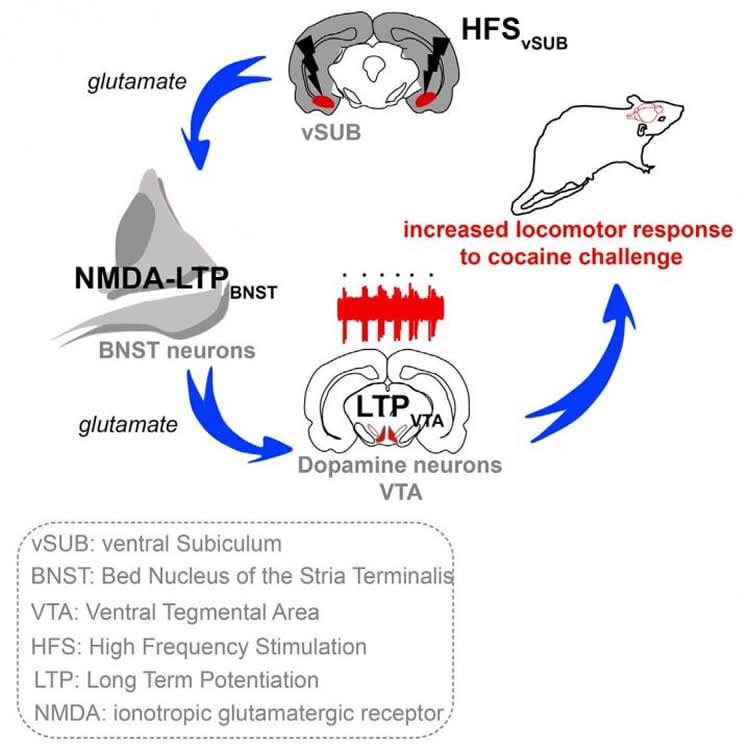The burst of energy and hyperactivity that comes with a cocaine high is a rather accurate reflection of what’s going on in the brain of its users, finds a study published November 25 in Cell Reports. Through experiments conducted in rats exposed to cocaine, the researchers mapped out the network of circuits that cause wild firing of neurons that produce dopamine, a neurotransmitter that regulates movement and emotion. The findings also help explain how cocaine use eventually leads to desensitization.
he researchers used tracer molecules to follow electrical activity in the brain in rats exposed to cocaine. They found that a hub of neurons in the extended amygdala (the brain’s motivation/learning center) acts as a relay between activation of the ventral subiculum (the brain’s addiction center) and the hyperactive release of dopamine.
Over time, increasing activation of a key part of the extended amygdala–the bed nucleus of the stria terminalis produces a long-lasting increase in signal transmission onto neurons that produce dopamine so that the rats became desensitized to the cocaine. Since this change happens within the amygdala, it may explain some of the long-term effects on behavior and motivation that occur after prolonged cocaine use.
“Unraveling the neuronal circuit and characterizing the synaptic mechanisms by which the ventral subiculum alters the excitability of dopamine neurons is a necessary first step in understanding the resulting behavioral changes induced by cocaine,” says senior author François Georges of Bordeaux University in France. “We show that the ventral subiculum recruits the bed nucleus of the stria terminalis to drive a persistent hyperactivity of dopamine neurons and control cocaine-induced activity.”
Surprisingly, a single stimulation of the ventral subiculum (which lasts about 10 minutes in an anesthetized rat) had the same impact on the brain and dopamine neurons as a massive injection of cocaine. These effects lasted up to five days and raise the possibility that dopamine-producing neurons can be changed so that they respond differently to stimuli.

In addition to providing insights on the circuits involved in drug addiction, the findings might be helpful for understanding and even changing the perception of natural rewards; for example, those related to food or exercise, which the authors plan to pursue next.
Funding: This work was supported by grants from Centre National de la Recherche Scientifique (CNRS), University of Bordeaux, Agence Nationale de la Recherche, Atip-Avenir, the City of Paris, and the European Research Council.
Source: Joseph Caputo – Cell Press
Image Credit: The image is credited to Glangetas and Fois et al./Cell Reports 2015
Original Research: Full open access research for “Ventral Subiculum Stimulation Promotes Persistent Hyperactivity of Dopamine Neurons and Facilitates Behavioral Effects of Cocaine” by Christelle Glangetas, Giulia R. Fois, Marion Jalabert, Salvatore Lecca, Kristina Valentinova, Frank J. Meye, Marco Diana, Philippe Faure, Manuel Mameli, Stéphanie Caille, and François Georges Cell Reports. Published online October 28 2015 doi:10.1016/j.celrep.2015.10.076
Abstract
Ventral Subiculum Stimulation Promotes Persistent Hyperactivity of Dopamine Neurons and Facilitates Behavioral Effects of Cocaine
Highlights
•vSUB controls the phasic activity of VTA dopamine neurons
•The BNST relays the excitatory drive from the vSUB to VTA dopamine neurons
•vSUB stimulation promotes persistent hyperactivity of VTA dopamine neurons
•vSUB-driven NMDA-LTP in the BNST gates cocaine-induced locomotor activity
Summary
The ventral subiculum (vSUB) plays a key role in addiction, and identifying the neuronal circuits and synaptic mechanisms by which vSUB alters the excitability of dopamine neurons is a necessary step to understand the motor changes induced by cocaine. Here, we report that high-frequency stimulation of the vSUB (HFSvSUB) over-activates ventral tegmental area (VTA) dopamine neurons in vivo and triggers long-lasting modifications of synaptic transmission measured ex vivo. This potentiation is caused by NMDA-dependent plastic changes occurring in the bed nucleus of the stria terminalis (BNST). Finally, we report that the modification of the BNST-VTA neural circuits induced by HFSvSUB potentiates locomotor activity induced by a sub-threshold dose of cocaine. Our findings unravel a neuronal circuit encoding behavioral effects of cocaine in rats and highlight the importance of adaptive modifications in the BNST, a structure that influences motivated behavior as well as maladaptive behaviors associated with addiction.
“Ventral Subiculum Stimulation Promotes Persistent Hyperactivity of Dopamine Neurons and Facilitates Behavioral Effects of Cocaine” by Christelle Glangetas, Giulia R. Fois, Marion Jalabert, Salvatore Lecca, Kristina Valentinova, Frank J. Meye, Marco Diana, Philippe Faure, Manuel Mameli, Stéphanie Caille, and François Georges Cell Reports. Published online October 28 2015 doi:10.1016/j.celrep.2015.10.076






